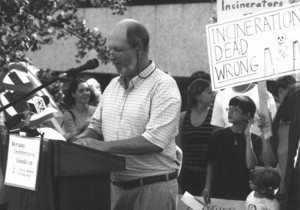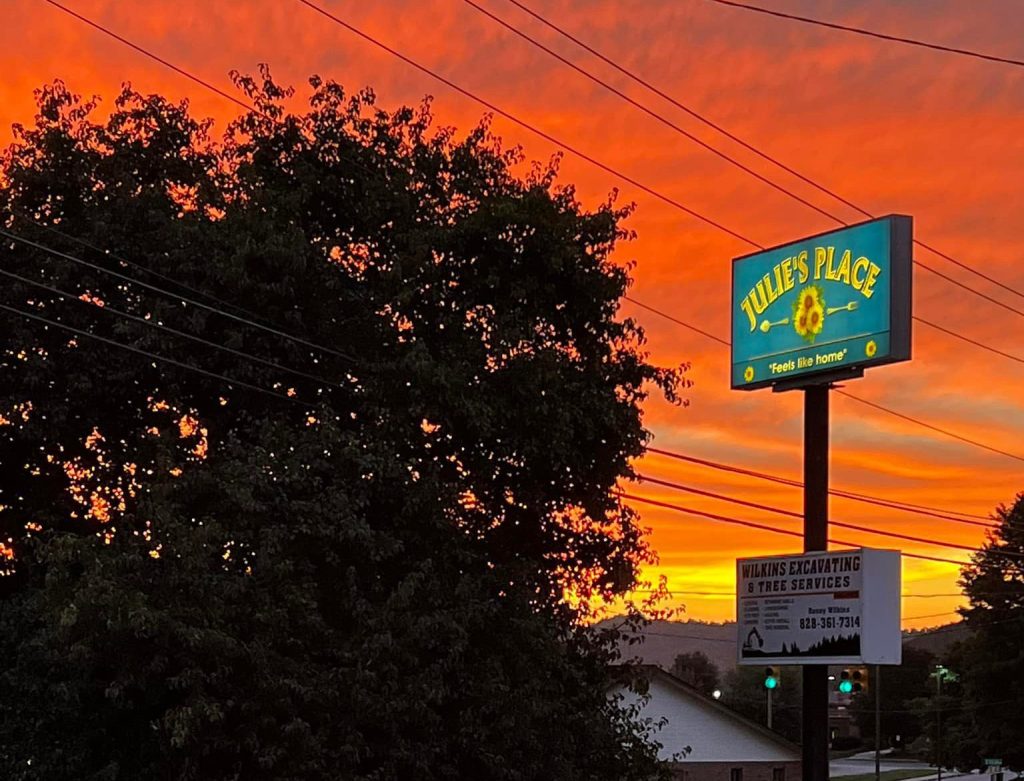Disposing of a Chemical Past
Kentucky chemical weapons stockpile slated for destruction by 2023

Craig Williams speaks about chemical weapons incineration at a rally. Photo courtesy Kentucky Environmental Foundation.
In a series of bunkers on the sprawling 14,500-acre Blue Grass Army Depot near Richmond, Ky., more than 100,000 rockets and projectiles containing more than 500 tons of nerve gas and other chemical weapons from World War II and the Vietnam War era are stored.
If all goes according to plan, those weapons will be destroyed over the next few years in a multi-billion facility in final stages of construction at the depot, finishing out a decades-long project that began when the United States joined the 1993 Chemical Weapons Convention.
The aging rockets and projectiles at the Blue Grass Army Depot are stacked in concrete igloos which have deteriorated over the years; about a third of them are covered with green plastic sheeting to keep out rain.
Low-level chemical leaks from the weapons have occurred over the past 10 years, including emissions of Sarin and mustard gas. Yet Army officials stress that no major leaks have escaped the igloos or threatened the surrounding community of Madison County, a fast-growing area of 85,000 residents.
The depot in Kentucky and Pueblo Chemical Depot in Colorado hold the country’s last remaining stockpiles of chemical weapons from the early-to-mid-20th century. The process to destroy them has taken much longer and cost much more than anticipated, largely because of wide-scale opposition to the original planned disposal method. The original budget for the the entire project was around $2 billion; the final cost will surpass $40 billion. Destruction of the Pueblo stockpile began in May.
When the United States first agreed to destroy its stockpile of chemical weapons in the 1980s, the Pentagon planned to incinerate most of it — including those stored at the Kentucky depot, much of which has been stored there since the 1940s.
That didn’t sit well with a lot of residents near the stockpiles, including Craig Williams, a Vietnam veteran and winner of the 2006 Goldman Environmental Prize for grassroots activism.
From the moment the Army publicly announced plans for an incinerator at Blue Grass in 1984, Williams and others lobbied for a more controlled and safer method of disposal. In 1992, the Chemical Weapons Working Group, part of the Kentucky Environmental Foundation that Williams helped found, released a report that described a dozen potential approaches that didn’t involve incineration.
“We took that report to the Army and to Congress and state regulators and to anyone else who would entertain the idea of listening,” says Williams. “We finally convinced Congress that there were viable options the Pentagon refused to research directly.”
According to Paul Walker, a former staff member of the U.S. House of Representatives Armed Services Committee, “The chemical weapons demilitarization process has shown that we can treat highly toxic and dangerous waste in a way that can be a win-win for everybody. We don’t have to push toxic remnants of war into the environment.”
Walker, who witnessed and helped guide the congressional response to the controversy in the early ‘90s, remained involved in the disposal process as head of the Security and Sustainability Program at Global Green USA, the U.S. national affiliate of Green Cross International, a nonprofit organization started by former Soviet Union president Mikhail Gorbachev.
“We are in the final few yards of eliminating an entire class of weapons of mass destruction,” Walker says.
The contentious political fight between Congress, local communities and the Pentagon, in the end, made for a better process, Walker says, and recognition that protecting the public health and the environment ultimately trumped cost or treaty deadlines.
At the Blue Grass facility, the Army settled on a method that breaks down the chemical bonds in the agents that make them lethal, a process that can be better controlled than incineration.

A view of the Blue Grass Chemical Agent-Destruction Pilot Plant. Photo courtesy Blue Grass Chemical Stockpile Outreach Office
Changes have taken place as the disposal facility has been designed and built. In one instance, the contractor recently suggested eliminating a step that involved rinsing rockets after they are disassembled to remove any remaining chemical agent, a process that could have created problems since water reacts with some of the agents, creating an acidic and corrosive material that could have compromised internal piping systems. According to Williams, the contractor developed an alternative method involving a thermal oxidizer and huge banks of carbon filters, along with a sophisticated detection and alarm system, which should safely neutralize any dangerous residue left on the rockets.
“Nothing’s perfect,” Williams says, “But our confidence is extremely high in the technology and the engineering of the facility. The risk mitigation efforts that have been taken will ensure that any issue or incident is minor compared to what it could have been with an incinerator.”
Walker hopes the lessons learned over the last 20 years of dealing with chemical weapons stockpiles will help the nation and world deal with other toxic legacies of war — like the chemical and conventional weapons dumped at various locations in the oceans.
“Most weapons were built to be used, not disposed of,” Walker says. “But historically, we never fire about 90 percent of the weapons we build. I’m not sure we’ll ever understand the public health impact of it all.”
NERVE:
How a Small Kentucky Town Led the Fight to Safely Dismantle the World’s Chemical Weapons
The Kentucky Environmental Foundation is creating a documentary about the community’s successful effort to stop the incineration of toxic nerve gas and other chemical weapons. Watch the trailer at kyenvironmentalfoundation.org/nerve-the-film.html
Related Articles
Latest News

Leave a comment
Your email address will not be published. Required fields are marked *





